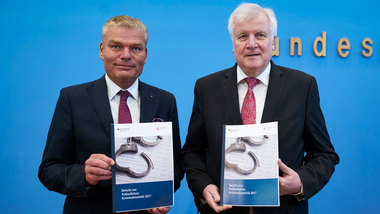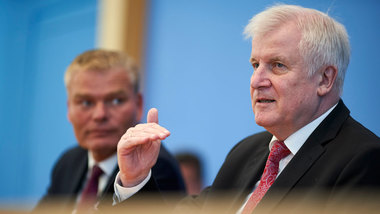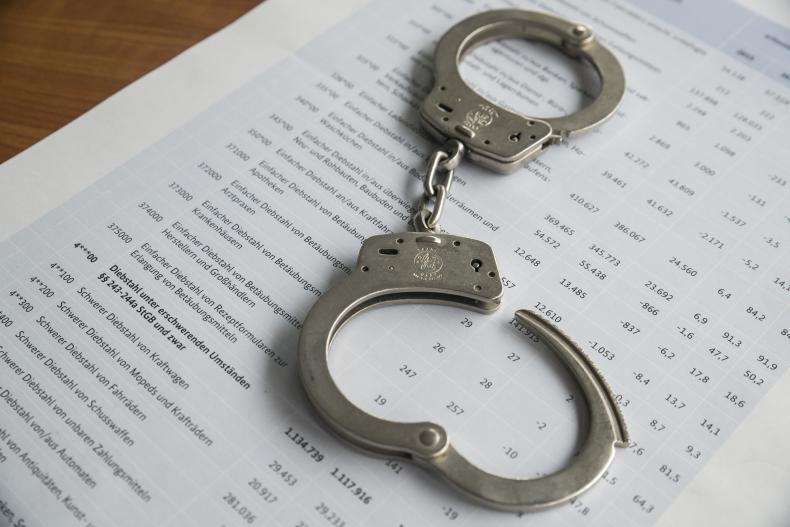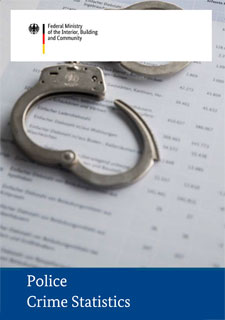Lowest number of criminal offences since 1992
press release
08 May 2018
Official police statistics on crime and politically motivated offences for 2017 presented
Federal Minister of the Interior Horst Seehofer and the interior minister of Saxony-Anhalt, Holger Stahlknecht, presented the official statistics on crime and politically motivated crime for 2017 in Berlin today.
In 2017, the police recorded 5,761,984 criminal offences. Not counting violations of law concerning foreigners (the Residence Act, Asylum Act and the Freedom of Movement Act/EU), this figure was 5,582,136, or 5.1% fewer offences than in 2016 (5,884,815).
Commenting on the statistics, Federal Minister Seehofer said, “At roughly 5.76 million, the number of criminal offences committed in Germany is the lowest since 1992. This drop in crime is even more apparent in relation to the total population: fewer than 7,000 offences per 100,000 residents. That is the lowest rate in more than 30 years!”
Positive and negative trends
The following statistics are based on criminal offences registered by the police in Germany as a whole, not counting violations of law concerning foreigners.

Holger Stahlknecht and Federal Interior Minister Horst Seehofer present the crime statistics for 2017 (Larger version opens in new window)
Source: Henning Schacht
The chairman of the Standing Conference of the Interior Ministers of the Länder in the Federal Republic of Germany, Holger Stahlknecht, and Federal Interior Minister Horst Seehofer present the crime statistics for 207
The share of cases solved was 55.7%, the highest since this statistic was introduced in 2005 (crimes not including violations of law concerning foreigners). In 2016, this figure was 54%. But there are wide variations depending on the type of crime. For example, although the share of domestic burglaries solved rose from 16.9% in 2016 to 17.8% in 2017, this figure is still low, compared to the clear-up rate for homicide offences, at 95.6%.
The number of suspects was slightly lower in 2017: 1,974,805 compared to 2,022,414 in 2016. Most suspected criminals are male (2017: 75.6%), and most are recorded by the police as having committed only one offence per year (2017: 73%).
As in the previous year, about 30% of all suspects were not German nationals; the absolute number fell from 616,230 in 2016 to 599,357 in 2017. Of this number, 27.9% were asylum applicants, beneficiaries of national or international protection, persons granted asylum status, persons whose deportation has been temporarily suspended, refugees admitted under humanitarian relief programmes or foreigners residing in Germany illegally. This group accounts for 8.5% of all suspects (2016: 8.6%).
Specific crime development
Cases of theft fell by 11.8% to 2,092,994, mostly the result of a 23% drop in domestic burglaries (116,450 cases in 2017) and a 22.7% drop in pickpocketing (127,376 cases in 2017).
Interior Minister Stahlknecht, chair of the Standing Conference of Federal and State Interior Ministers, commented, “The trend with regard to domestic burglaries shows that rigorous law enforcement can lead to success. In recent years, we noted a worrisome increase in the number of home break-ins: In 2015, more than 167,000 break-ins were recorded in the official statistics. The federal and state authorities took a broad range of measures, resulting in 50,000 fewer cases in only two years, a drop of more than 30%!”
In 2017, 188,946 cases of violent crime were recorded nationwide (2016: 193,542 cases), including 137,058 cases of dangerous and serious bodily harm (2016: 140,033). Compared to the previous year, violent crime was down slightly by 2.4%.
The number of cases rose in the following fields of criminal activity: violations of the Weapons Act (+ 10.3% to 38,001 cases); drug crime (+ 9.2% to 330,580 cases) and distribution of pornographic material (+ 12.9% to 10,066 cases).
Economic crime increased by 28.7% to 74,070 cases, as the result of a complex investigation which was completed in 2017.
Trends in politically motivated offences
After increases in the past four years, the number of politically motivated offences fell by 4.9% to 39,505, including 3,754 violent offences (a drop of 12.9%). While the number of right-wing extremist politically motivated offences fell by 12.9%, the number of left-wing extremist politically motivated offences saw an increase of 3.9% (20,520 right-wing extremist offences; 9,752 left-wing extremist offences).
Most of these (33.9%) were propaganda offences, such as using symbols of unconstitutional organizations, according to Sections 86 and 86a of the Criminal Code. At 58.6%, propaganda offences accounted for more than half of all right-wing extremist politically motivated crime.
By far the most violent offences were recorded in the field of left-wing extremist politically motivated crime: 1,967, an increase of 15.6% over the previous year. By contrast, the number of right-wing extremist politically motivated violent offences fell by 33.5% to 1,130.

Holger Stahlknecht and Horst Seehofer during the press conference (Larger version opens in new window)
Source: Henning Schacht
Holger Stahlknecht and Horst Seehofer during the press conference
Federal Minister Seehofer commented, “The increase in violent left-wing extremist offences is largely due to the rioting during the G-20 summit in Hamburg. The rioters demonstrated an unprecedented level of aggression and willingness to deliberately harm the life and limb of the police officers on duty.
It is especially reprehensible that photos of officers who served in Hamburg were posted on the Internet and in left-wing gathering places this spring. I find it disgraceful that the Left Party has not distanced itself from these actions. We sent a clear signal by banning the Internet platform ‘linksunten.indymedia’.
I would also like to see the state and local authorities taking more decisive action against centres of left-wing autonomous activity. We cannot allow any lawless areas or public support for violent left-wing extremists.””
Fewer attacks on shelters for refugees and asylum seekers
There were also far fewer attacks on shelters for refugees and asylum seekers. In 2017, the number of these offences fell by 68.6% to 312 (2016: 995), continuing the downward trend which started in February 2016 and returning to a level similar to that before the major wave of immigration in 2015 and 2016.
Federal Minister Seehofer commented, “That is also thanks to the work of the security authorities. Following their comprehensive investigations, the law enforcement authorities were able to prove that the Freital group had used explosives to attack shelters for refugees and asylum seekers. I am glad that eight members of this group were convicted in March of forming and belonging to a terrorist organization and were sentenced to five to ten years in prison.”
Criminal offences in the field of foreign and religious ideology
In the field of politically motivated crime – foreign ideology, most offences were related to the Kurdistan Workers’ Party (PKK), Kurds and/or Turkey. Compared to 2016, the number of these offences fell by 32% to 1,028 in 2017 (2016: 1,518). This drop can be attributed to the lack of possible occasions for politically motivated crime.
In the field of politically motivated crime – religious ideology, 1,102 criminal offences were recorded in 2017, with 95% of them having an Islamist background.
More antisemitic offences
Antisemitic offences rose by 2.5% over the previous year (2016: 1,468; 2017: 1,504). Almost all of these offences can be attributed to the right-wing milieu (94%).
Federal Minister Seehofer said: “In recent weeks, we have seen greater media attention to antisemitic incidents. In Berlin, a seven-year-old was mocked by older schoolchildren from Muslim families because of her Jewish faith. Two rap musicians won an Echo music prize for songs with antisemitic lyrics. And a young Israeli was attacked in Berlin’s Prenzlauer Berg neighbourhood for wearing a yarmulke.
So it is no wonder that ‘imported antisemitic criminal offences’ are on the rise, even if the overall number is low. But I would like to point out that, out of the 1,504 antisemitic offences recorded in 2017, nearly 95% were motivated by right-wing extremism.
Many victims of antisemitic offences hesitate to go to the police. For this reason, the Federal Ministry of the Interior started a research project late last year to bring together civil society and the police to fight crime based on prejudice, to foster trust and encourage closer cooperation.
Antisemitic incidents which do not constitute a crime but still threaten understanding between religions and cultures must be documented and analysed. Schools and educational authorities are also called on to help.
I am pleased that Dr Felix Klein, who was just appointed Federal Government Commissioner for Jewish Life in Germany on 1 May, has already clearly staked out his positions for his important job.””
Criminal offences committed by so-called Reichsbürger and Selbstverwalter
Criminal offences committed by so-called Reichsbürger (“citizens of the Reich”) and Selbstverwalter (“self-governers”) were recorded separately for the first time in the 2017 statistics on politically motivated crime. Supporters of this anti-government movement committed a total of 911 criminal offences in 2017, including 144 violent offences.
Of the total, 380 were right-wing extremist politically motivated offences, while 531 could not be attributed to any particular political orientation. This confirms the hypothesis that the Reichsbürger and Selbstverwalter movement is very heterogeneous in terms of political ideology, and that only some of its members can be considered right-wing extremists. Because Reichsbürger reject the state and its laws, most of the offences involved resisting law enforcement officers.
You can find additional information on the website of the Federal Criminal Police Office (BKA).
Originally published at https://www.bmi.bund.de/SharedDocs/pressemitteilungen/EN/2018/police-statistics-on-crime-2017.html;jsessionid=F260DA8FA8F9ADD5C9FF23899B346EBE.2_cid322







